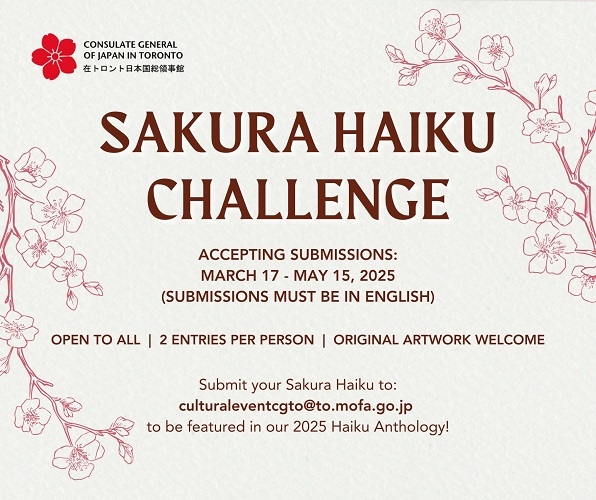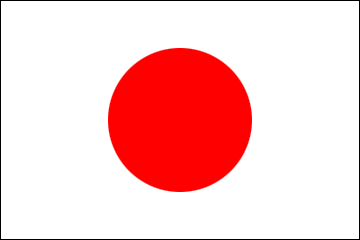Consulate-General of Japan in Toronto Invites Submissions to the SAKURA Haiku Challenge 2025
2025/3/17

The Consulate-General of Japan is once again accepting submissions of haiku on the subject of Sakura (Japanese cherry blossoms), as well as original artwork/photos on the same topic. Let your creativity bloom like Sakura blossoms and send us your creations!
Submission Period: March 17 to May 15, 2025
Apply: By e-mail culturaleventcgto@to.mofa.go.jp
Subject line: Sakura Haiku Challenge 2025 – Your Name, or initial, pen name
Subject line: Sakura Haiku Challenge 2025 – Your Name, or initial, pen name
Guidelines & Eligibility
- Challenge is open to everyone and all ages
- Up to TWO (2) entries per person
- The haiku should touch on the theme of blooming Sakura
- All submissions must be in English
- Submitted haiku must be an original piece of work by the entrant
- Submissions may be accompanied by one artwork or photo, but it MUST be an original piece of work by the author of the haiku
- Entries with vulgar, offensive, or sensitive content will not be accepted. We will review every submission and retain the right to not post any materials we deem inappropriate on our social media, website or other publications.
How to submit
Please send the information below and attach your artwork/photo related to your Haiku if applicable. NOTE: If so, the image file cannot be larger than 8MG in size.
*Approved entries will be collected in an electronic anthology.
- Full Name
- If your Haiku is approved, do you give us permission to post it on our social media (Facebook & X)? ☐ Yes / ☐ No
- Do you also give us permission to publish your full name? ☐ Yes / ☐ No
- If you answered “No” to above, please describe how you would like to be credited (e.g.: initials, pen name, etc.)
- Do you understand and agree with the guidelines and eligibility? ☐ Yes / ☐ No
- Which Country (or Province, Territory, State) are you from?
- How did you learn about this event? ☐ Consulate website ☐ Consulate Facebook/Twitter ☐ Other _______________
*Approved entries will be collected in an electronic anthology.
Information on Haiku
What is Haiku?
Haiku originated in Japan and is the world’s shortest form of poetry. Haiku uses simple yet poignant expressions of imagery and conventionally requires the use of Kigo, a word associated with a particular season.
Haiku began as Hokku, the opening stanza of linked poems called Renga. Around the time of the famed poet Matsuo Bashō (1644–1694), hokku began to appear as a separate, independent form of poetry. This distinct form of Hokku was renamed Haiku in the late 19th century.
A traditional Japanese Haiku consists of three lines containing 17 syllables in total (divided as 5-7-5). However, because many contemporary poets do not adhere to this convention, we are no longer requiring this structure for the Challenge. However, since Haiku is conventionally defined by its short length, three-line poems are desirable.
If you have any questions, please feel free to send us an email at culturaleventcgto@to.mofa.go.jp
Haiku originated in Japan and is the world’s shortest form of poetry. Haiku uses simple yet poignant expressions of imagery and conventionally requires the use of Kigo, a word associated with a particular season.
Haiku began as Hokku, the opening stanza of linked poems called Renga. Around the time of the famed poet Matsuo Bashō (1644–1694), hokku began to appear as a separate, independent form of poetry. This distinct form of Hokku was renamed Haiku in the late 19th century.
A traditional Japanese Haiku consists of three lines containing 17 syllables in total (divided as 5-7-5). However, because many contemporary poets do not adhere to this convention, we are no longer requiring this structure for the Challenge. However, since Haiku is conventionally defined by its short length, three-line poems are desirable.
If you have any questions, please feel free to send us an email at culturaleventcgto@to.mofa.go.jp
